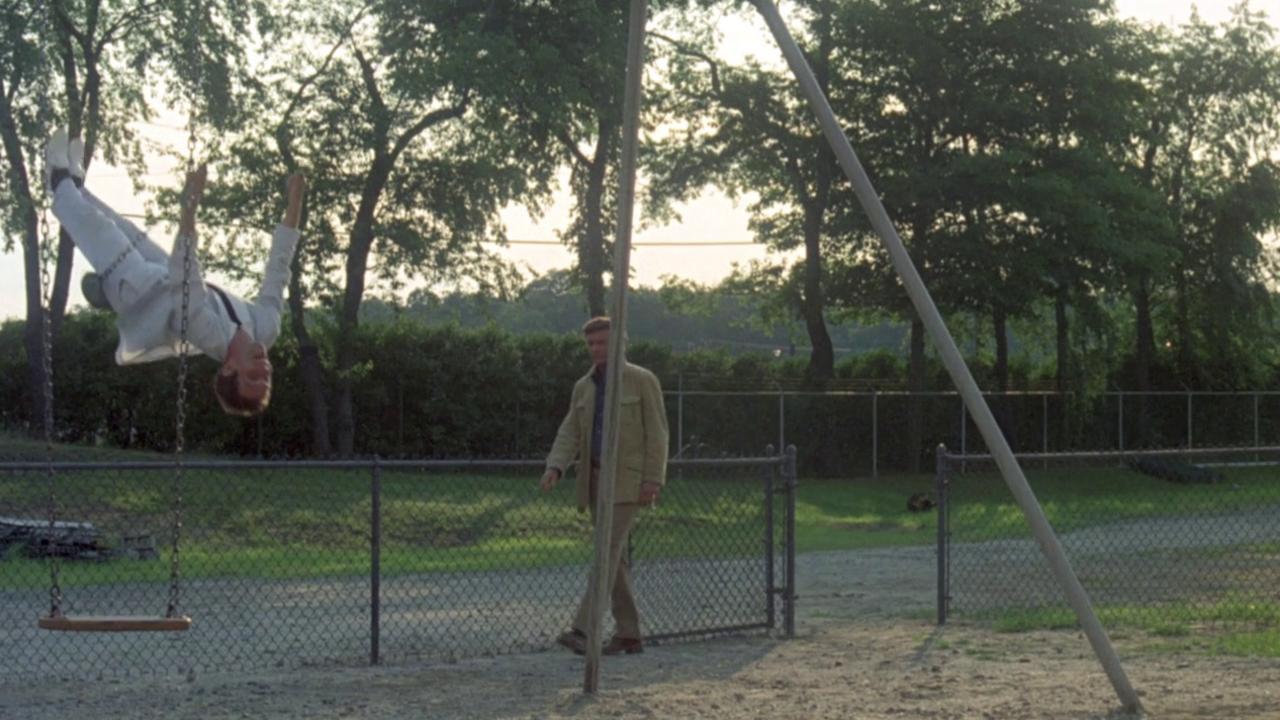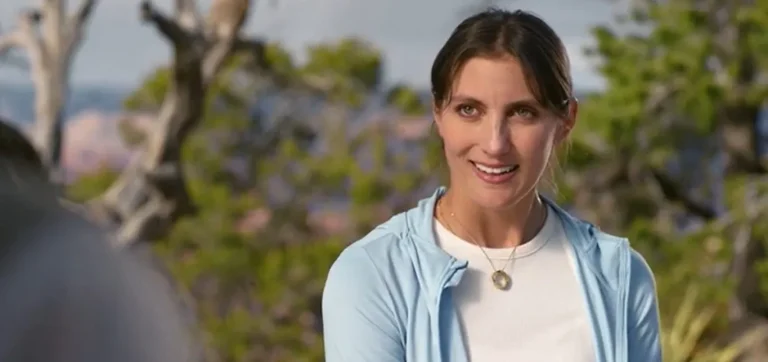Joel Grey in ‘Man on a Swing’ (1974): In the early 1970s, US director Frank Perry (of the ‘David and Lisa,’ ‘The Swimmer’ fame) had just come out of two back-to-back, women-in-distress character studies: ‘Diary of a Mad Housewife’ (1970) and ‘Play It as It Lays (1972). Actor, singer, and dancer Joel Grey, on the other hand, who celebrates his 91st birthday this April (born April 11, 1932), was just fresh from his Academy Award win as the Master of Ceremonies in Bob Fosse’s ‘Cabaret’ (1972) – and waiting for his next starring vehicle.
Hardly two personas to explore cinematically the alpha male concept that crime films usually embody, the two met in the now largely forgotten but still mesmerizing detective/crime story ‘Man on a Swing’ (1974). The film is based on an actual 1968 Ohio incident of a teacher being found murdered in her car in a shopping mall and the subsequent investigation.
The script by David Zelag Goodman (‘Straw Dogs’) was itself based on the non-fiction chronicle ‘The Girl on the Volkswagen Floor’ (1971) by journalist William Arthur Clark. It details the official participation of a self-professed clairvoyant, Franklin Wills (Joel Grey), in the investigation of Maggie Dawson’s murder. The original clairvoyant agent, the Cincinnati radio host Bill Boshears, died in 2021. The investigation is conducted by chief police officer Lee Tucker (Cliff Robertson, in his most stern and perplexed mood).
If that sounds like an early ‘Silence of the Lambs’ pitch (minus the cannibalism), it certainly is. The film, which is somehow lost in its many false leads and crime details, gets uplifted by the relationship between Wills and Tucker, in which Wills can give his advice for free in turn of a glimpse to (and taking over) Lee Tucker’s provincial soul. Their relationship fuels the film more than the whodunit part, as Franklin Wills gets increasingly impatient by what he considers negligence on behalf of the inspector to get his leads right, and Tucker gets increasingly suspicious that the many clues Wills provides are simply first-hand experience i.e., he might be the murderer.
But if we move a little deeper than that, we discover a carefully laid-out character map of masculinity in ‘Man on a Swing.’ The first suspect, the previous offender Richie Tom Keating (Christopher Allport), is as arrogant and non-cooperating as all the generation of James Dean / Dennis Hopper acolytes would have it. The second suspect, Maggie’s boyfriend (Gil Gerard), is the young and fit version of the American male. The police detective himself is still a handsome but now caring husband of his pregnant wife (with some bouts of alcohol consumption on his record to retaliate for his family-imposed duties – alcoholism is a male sport in the film).
And amid this kaleidoscopic map, Joel Grey, in his first appearance as Franklin Wills, 25 minutes into the film, gets a shot fixed on his white suede shoes, dancing his way down the stairs to the police station headquarters. We later learn that dancing was the passion of the victim too, and a liberating experience all by itself. Immaculately dressed in a purple suit, he looks like a person coming from an altogether different era and environment – from a town where the police officials are too clumsy to leave their fingerprints on the crime scene.
This is a totally kinetic performance by Joel Grey, so omnipresent in the film (whose direction almost does nothing but observe him) that it runs the danger of making the character a freak show agent. Helped by the perenially eerie score of Lalo Schifrin, Grey falls into a trance, wakes up again, bumps into the objects, rises to the ceiling – and, of course, uses the playground swing of the title for his exposure. It is his version of occupying space more than the environment he’s in that allows him to do so: a married man of four children, a conscientious yet indistinguishable factory worker who desperately craves attention, even though he never subscribes to magazines or reads the newspapers.
The attention Franklin Wills needs (and the ‘Cabaret’ androgynous MC persona and its grin is never lost in this film as well) has more to do with emulating or performing the perfect crime. Here we are led by Franklin Wills to associate his version of queerness with the intellectualized, debonair crime that the two gay protagonists of Hitchcock’s ‘Rope’ (1948) performed. Whether Wills had or did not have any direct relation to the murder itself, he certainly reenacts the murder, mimicking both the female victim and the male perpetrator in all the gruesome details.
Wills can do both the dancing-like steps of the victim when she leaves her place, and he is certainly convincing (and pressing) when he reenacts in precise detail the strangulation process by the murderer. Being constantly nervous (never a sign of an alpha male), he prominently declares that he needs to move away from ‘getting other people’s vibrations’ to fulfill his clairvoyance task. Rehearsing the Nietzschean Übermensch pattern, he uses his clairvoyant ability (itself contested) more as a ploy to elevate him above conventional morality. He declares that he rejoices in the fact of knowing beforehand that all kinds of tragedies will happen but will not necessarily care for their victims.
His commitment to this mission has a religious feel, even though he has distanced himself from the church service. “My work is my religion,” he claims to a couple of befuddled psychiatrists who have come to test his abilities. But, unlike the gay protagonists in Hitchcock’s 1948 thriller, he mixes his version of transcendence with an understanding of being the perfect reenacting tool of the male and female genders’ ‘typical’ behavior. Only when in a trance, of course; he still needs to be a male provider for a family of five.
Where does the police detective fit into this? Unlike Clarice Starling in ‘The Silence of the Lambs’, Lee Tucker does not have many skeletons in his closet, apart from his insecurities about being a first-time father. Yet Tucker has his own infatuation with the murdered girl, leaving him vulnerable to his wife’s insinuations (a whole tense film scene is dedicated to that) and Wills’ shenanigans. The more he can dig into the life of the murdered ‘Maggie’ (he refers to her by her first name only), the better for Lee Tucker. It is his middle-class dream of an extramarital adventure that Wills could help him fulfill.
It turns out that the need is mutual. Wills needs Tucker as much as Tucker needs him. For all his flamboyant demeanor and grand plans, Wills is still a man who has been rejected from ‘proper’ ESP societies. And his having to abide in a small town certainly won’t do much to his fame (the film was shot in Milford, Connecticut). Publicity is the credit Wills needs, and Tucker seems to be the best instrument to implement it. Homoeroticism and bromance are absent here. Wills’ relationship with Lee Tucker is mostly an impersonal business transaction. A little bit of male lover reassurance for Tucker and his dead (and therefore safe) object of desire will be compensated by a little bit of publicity for Wills.
Yet the relatively meager result of this proposed exchange does nothing to diminish Wills’ perseverance and Grey’s intensity in his many confrontations throughout the film. The whole second part of ‘Man on a Swing’ suddenly switches from an investigation of Maggie’s murder to the inspector himself and the warning signs he needs to face by neglecting or denying Wills’ interference.
In the film’s most horrifying scene (shot in perfect daylight), Wills visits Janet, Lee’s pregnant wife (Dorothy Tristan), apparently for no reason whatsoever – if only to intimidate her. His sophisticated appearance and the offer of a handkerchief to wipe her nose swiftly turn into demand to take his handkerchief. Janet understands this has suddenly become a violation of her private space, and she refuses the offer. Undeterred, Wills continues, and Grey’s voice is raised, his eyes penetrating her. Janet has no option but to oblige and take his handkerchief. His voice pitch returns to normal, and his suave demeanor returns. He finds himself successful in this little game of dominance.
The events that follow and directly involve Lee Tucker may or may not have been caused by Wills himself, but his mark is indelible. He makes clear that any attempt not to use his self-professed help (a ‘capacity’ which he never uses for profit) will have its consequences, up to the film’s open ending. The police detective is now being relegated to being one part of the swing mechanism. Lee Tucker is the swinging instrument and grounding on which the provincial, wannabe Übermensch needs to rest before he starts dancing his way through.
Frank Perry has subsequently put characters on screen that test their limits and the limits of others (think of the justifiably camp icon of Faye Dunaway in ‘Mommie Dearest’). Yet his men are mostly of the sad, unapproachable variety, like the haphephobic David (Keir Dullea) in ‘David and Lisa’ or the cynic and detached gay film producer BZ (Anthony Perkins) in ‘Play It as It Lays.’
The Franklin Wills character, literally performed by Joel Grey (who came out as gay in 2015), works both as an ESP attraction show to be watched and an experiment of testing an androgynous, above-conventional morality behavior as a substitute for living a dull, by-the-clock life. As all Nietzschean experiments go, this is a recipe for crime and disaster. The film’s genre (and Frank Perry) won’t permit a more positive, less incriminating characterization; Franklin Wills might not be sad, but he’s still of the mad variety. Yet Joel Grey himself makes this character utterly seductive and memorable.





![The 400 Blows [1959]: An unsentimental film about Adolescence](https://79468c92.delivery.rocketcdn.me/wp-content/uploads/2015/12/vlcsnap-2015-12-01-22h42m06s658.png1.jpg)

